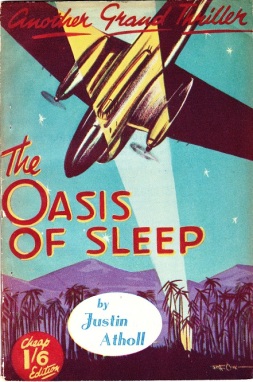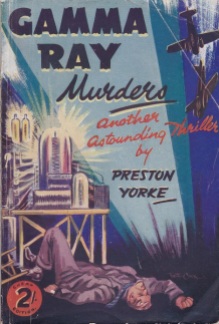Over two decades ago, I made a conscious effort to shift from American publications to British, with a focus on wartime and postwar mushroom publishers.
While visiting the house, or, more precisely, the attic of Howard Devore, I purchased a few wartime efforts by the Mitre Press. One was “The Man Who Tilted the Earth” by Justin Atholl. The copy appeared to me desperately distressed, with worn covers and fraying, well-thumbed edges. However, this title is not the point of this article. The point is, I love the crudely executed artwork that burped into existence seemingly only during those war years.

The Atholl cover was not signed, but, I had read the story and began hunting further Atholl books. My next title was “The Oasis of Sleep.” This was signed by illustrator Jeff Cook, and the vibrantly bold style caught my eye immediately. I wanted more by this guy. But, what other books had he illustrated? The Internet was still young back then, I was still on dial-up, and I was on the wrong side of The Great Pond to pursue a research endeavor at the British Library. So, I did it the hard way, and learned that Jeff Cook did not simply appear during the war years.
He began much earlier….
The earliest illustrated effort by Jeff Cook appears to be actually not with books, but, on sheet music covers! His artwork can be found on pieces released by Lawrence Wright Music Company (as early as 1929), B. Feldman & Co., Gilbert & Nicholls, and Cecil Lennox Ltd., etc. The last known piece that I have traced appears in 1935, with perhaps one further in 1940. For the most part, none of the covers are exciting. So, how did he hop from sheet music to book covers? I haven’t the foggiest, but, I hold out hope that someone from his family may one day find this article and fill in the blanks.
Moving along, the earliest known book illustration occurs in 1933, with children’s books for the publishers Art & Humour Publishing:
- “Elfin Adventures“
- “Woodland Fairies“
He next appears handling a handful of dust jackets for Wells, Gardner & Co., illustrating the covers of the following books:
- Alice A. Methley “Summer Hours and Summer Flowers” (1937)
- Alice A. Methley “Winter Days and Winter Ways” (1937)
- William Rainey “Admiral Rodney’s Bantam Clock” (1938)
- Harold Bindloss “The Boys of Wildcat Ranch” (1938)
- Daniel DeFoe “Robinson Crusoe in Short Words” (?)
cover art by Gordon Robinson, with interiors by GR and Cook
From 1939 to 1941, I have found no evidence of his output. Could be I simply haven’t located them yet, or, perhaps, he enlisted. Cook resurfaces, illustrating several covers for Everybody’s Books and Mitre Press, from 1942-1944.
He then turned his hand to children’s books, illustrating covers and supplying interior art for the Walker Toy Book ‘Dinky Series’ published by Renwick of Otley, with such titles as:
- “Kitchen Capers” (#75)
- “The Old Chimney Corner” (#80)
- “The Old Mill” (#83)
- “Scarum Sam” (#87)
- “Tea Time Tale“(#91)
Also for the same publishers, “Our Boys’ Tip Top” was an omnibus loaded with tales by F. W. Gumley and others. The frontispiece was by Jeff Cook, and internally, he supplied illustrations to tales by Arthur Groom and L. E. Shorter.
Additionally, he supplied art to at least one postcard, for “The White Horse Hotel, Bampton, Devon.”
So, who is Jeff Cook? With his earliest known piece appearing circa 1930, I wanted to believe that he got into illustrating at a fairly young age, perhaps out of high school or college. With that purely as my basis, this, below, I believe to me by man. If anyone has any further information about Jeff Cook, please contact me.
Jeffrey Cook (11 Feb 1907, died 13 Oct 1979)
son to Frederick COOK and Kate Annie ROWLAND (married 1894)
siblings:
Gladys (10 May 1900; died 1982)
Clifford (Dec 1905)
Bernard (19 Feb 1908; died 1990)
Kate (3 Feb 1910; died 1998)
Elizabeth (20 Dec 1914; died 1999)
It’s also possible he had two earlier sibs, names of Donald and Hilda.







 I have not spent any real time investigating the identity nor the history surrounding Sidney Gainsley. If any family-members ever read this article, I should love to learn more about Sidney, his exploits in publishing, etc. However, from what little investigative efforts I have made, I know that Sidney was born in 1912 and died 1982 in Sutton, Surrey, England.
I have not spent any real time investigating the identity nor the history surrounding Sidney Gainsley. If any family-members ever read this article, I should love to learn more about Sidney, his exploits in publishing, etc. However, from what little investigative efforts I have made, I know that Sidney was born in 1912 and died 1982 in Sutton, Surrey, England.
